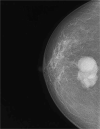Malignant adenomyoepithelioma of the breast: A case report
- PMID: 33592899
- PMCID: PMC7870234
- DOI: 10.1097/MD.0000000000024461
Malignant adenomyoepithelioma of the breast: A case report
Abstract
Rationale: Adenomyoepithelioma (AME) is a rare biphasic tumor consisting of epithelial and Myoepithelial cell. Most of the AME is benign, and only a few will progress to malignancy, Here, we report a case of low-grade malignant adenomyoepithelioma, and review the related literature, in a bid to investigate its clinical and pathological features and thus, enhance our understanding of this tumor.
Patient concerns: A 64-year-old woman visited our hospital with a 1-year history of a painless mass in her left breast. Physical examination revealed a palpable painless mass, measuring approximately 4.5 cm, in the left breast.
Diagnosis: Histological examination confirmed the diagnosis of malignant adenomyoepithelioma.
Interventions: The patient underwent local excision of the mass, with frozen section analysis revealing ductal carcinoma in situ. Mastectomy and sentinel lymph node biopsy were then performed.
Outcomes: We conducted a one-year follow-up, and relapse was not observed.
Lessons: Treatment of AME remains controversial owing to the lack of high volume data and absence of prospective studies. Simple mastectomy is an acceptable treatment of this tumor.
Copyright © 2021 the Author(s). Published by Wolters Kluwer Health, Inc.
Conflict of interest statement
The funding/conflict of interest information is: Department of Science and Technology of Jilin Province (3D5204177428).
Figures


Similar articles
-
ADENOMYOEPITHELIOMA WITH CARCINOMA; EPITHELIAL-MYOEPITHELIAL CARCINOMA WITH EARLY PULMONARY METASTASIS.J Ayub Med Coll Abbottabad. 2024 Jul-Sep;36(3):667-669. doi: 10.55519/JAMC-03-13011. J Ayub Med Coll Abbottabad. 2024. PMID: 39623855
-
Malignant Adenomyoepithelioma of the Breast and Associated Epithelial-Myoepithelial Carcinoma; A Rare Case Report.Int J Surg Pathol. 2022 Aug;30(5):569-573. doi: 10.1177/10668969211070164. Epub 2022 Feb 9. Int J Surg Pathol. 2022. PMID: 35138180
-
Breast adenomyoepithelioma and adenomyoepithelioma with carcinoma (malignant adenomyoepithelioma) with associated breast malignancies: A case series emphasizing histologic, radiologic, and clinical correlation.Breast. 2016 Oct;29:132-9. doi: 10.1016/j.breast.2016.07.018. Epub 2016 Aug 3. Breast. 2016. PMID: 27494340
-
Adenomyoepithelioma with a human epidermal growth factor receptor 2-fluorescence in situ hybridization-confirmed ductal carcinoma in situ component: A case report and review of the literature.Medicine (Baltimore). 2020 Oct 16;99(42):e22665. doi: 10.1097/MD.0000000000022665. Medicine (Baltimore). 2020. PMID: 33080708 Free PMC article. Review.
-
Adenomyoepithelioma of the breast with late pulmonary metastases - case report and review of the literature.J Cardiothorac Surg. 2016 Aug 4;11(1):121. doi: 10.1186/s13019-016-0518-8. J Cardiothorac Surg. 2016. PMID: 27487934 Free PMC article. Review.
Cited by
-
Adenomyoepithelioma of the breast with malignant transformation and repeated local recurrence: A case report.World J Clin Cases. 2021 Oct 16;9(29):8864-8870. doi: 10.12998/wjcc.v9.i29.8864. World J Clin Cases. 2021. PMID: 34734068 Free PMC article.
-
Targeting malignant adenomyoepithelioma of the breast: clinical insights on multimodal therapy and disease-free survival.Discov Oncol. 2025 Mar 18;16(1):349. doi: 10.1007/s12672-025-02120-2. Discov Oncol. 2025. PMID: 40100534 Free PMC article.
-
Malignant adenomyoepithelioma of the breast: cases report and literature review.Am J Transl Res. 2022 Dec 15;14(12):8788-8792. eCollection 2022. Am J Transl Res. 2022. PMID: 36628238 Free PMC article.
-
Malignant adenomyoepithelioma of the breast with axillary lymph node metastasis: a case report and review of the literature.Front Oncol. 2025 Mar 6;15:1496057. doi: 10.3389/fonc.2025.1496057. eCollection 2025. Front Oncol. 2025. PMID: 40115008 Free PMC article.
References
-
- Hamperl h. The myothelia (myoepithelial cells). Normal state; regressive changes; hyperplasia; tumors. Curr Top Pathol 1970;53:161–220. - PubMed
-
- Tan PH, Ellis IO. Myoepithelial and epithelial-myoepithelial, mesenchymal and fibroepithelial breast lesions: updates from the WHO Classification of Tumours of the Breast 2012. J Clin Pathol 2013;66:465–70. - PubMed
-
- Jones M, Fletcher J. Malignant adenomyoepithelioma of the breast. Pathology 2017;49:322–5. - PubMed
Publication types
MeSH terms
LinkOut - more resources
Full Text Sources
Other Literature Sources
Medical

